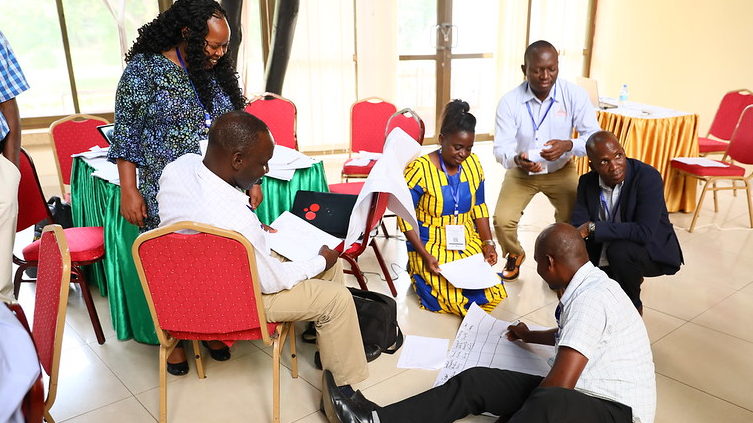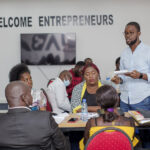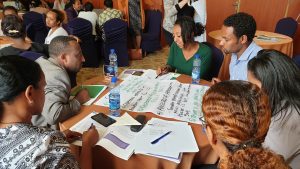
How can you transform teaching and learning to make it more relevant? Learning from our colleagues in Tanzania and Uganda at the USAID Higher Education Summit
On 10 May, INASP and TESCEA partners hosted a panel session as part of the USAID Higher Education Global Evidence Summit. Jon Harle (INASP, Director of Programmes), Tupokigwe Isagah (Mzumbe University), Gloriana Monko (University of Dodoma), and Walter Odongo (Gulu University) discussed what the team have learnt from the last four years of leading change and how the newly developed East African model can help other universities transforming their teaching and learning.
[Photo: top left – Gloriana Monko; bottom left – Walter Odongo; top right – Tupokigwe Isagah; bottom right – Jon Harle]
The session begun by introducing the model that the partnership developed: Transforming Higher Education for Social Change – a Model from East Africa.
You can explore the full model here and read more about it in this blog from Mai Skovgaard.
As we explained in the session, it’s a collection of tools for faculty members and university leaders to guide the process of transforming teaching and learning. They’re designed so that:
- faculty are teaching for critical thinking and problem-solving skills
- students learn how to think not what to think
- communities and employers are part of the process
- curricula are relevant and prepare students for lives and careers beyond university
- learning environments become more inclusive
- academics and students can make the change together, supported by university leadership
While many approaches to curriculum and pedagogy reform are borrowed from the North, our model was developed in East Africa. We followed a rigorous process of pedagogical training and course redesign, where lecturers and students were directly involved in piloting and testing the approach and the materials. Initial results have been very positive:
- 91% of academics reported using gender-responsive pedagogies
- 80% of reported using critical thinking techniques
- 87% of students had positive experience of new teaching and learning
Many approaches to curriculum development also start with what academics know, and what they think their students need to know. We approached it differently, by convening students, lecturers, local businesses, employer associations, representatives of the community, and national policy makers through Joint Advisory Groups (JAGs). The JAGS were asked, “what skills and competencies do our graduates need?” and “how can you help us to develop better graduates?”
The model also centres the student – to make sure students have a meaningful learning experience and encouraging them to think for themselves. It does this by focusing on the key skills that students need and supporting academics to teach for critical thinking and problem solving, alongside other key skills. And because opportunities to progress and succeed in higher education can be unequal, it puts gender-responsive pedagogy at the heart and asks how classrooms and campuses can be more inclusive and works with lecturers to make their teaching gender-responsive.
Redesigning courses to make them more relevant and more engaging for learners
Tupokigwe Isagah explained how she and colleagues at Mzumbe University, Tanzania have made their teaching more relevant to learners. She noted the importance of updating courses based on current employment trends, and on involving people from industry to provide professional experience, as well as using local case studies. At Mzumbe they did this by integrating local scenarios or challenges into their teaching, where students are required to solve a local problem using the knowledge acquired in class, and by giving students projects at the beginning of the course, which require them to produce specific pieces of work as they learn. This makes them value and see the benefits of the course, Tupokigwe noted.
Gloriana Monko from the University of Dodoma (UDOM) in Tanzania discussed how – if they saw themselves as facilitators of learning rather than lecturers – she and her colleagues could help their students learn to think and to solve problems.
She highlighted the need to revise and re-design courses so that they engage students. The learning outcomes of the course should speak to learners, she explained, so that learners understand what they are expected to become at the end of the course.
Gloriana also emphasized that facilitators of learning should move towards a learner-centred approach and use active learning methods, that ask students to engage in their learning by thinking, discussing, investigating, and creating, and by giving them space to express themselves. Timely feedback, from either the instructor or fellow students through peer assessments, is critical to the learning process she noted.
Walter Odongo from Gulu University in Uganda explained that because the norm has been a very teacher centred approach, where students listen and take in information, “When you change the approaches, the first response of students is to resist. They don’t want to change the way they learn, to be active in class or to prepare materials. It is unsettling for them; it makes them uncomfortable.” But, Walter explained, “if you insist, if you persevere, and give them assignments that are connected to their real-life experiences, they begin to appreciate it. It might not be until the middle or towards the end of the course that you see that, but they do see that they become able to learn for themselves.”
Making teaching and learning gender-responsive
Gloriana talked about the University of Dodoma’s aim to make classrooms and teaching inclusive of female and male students. She stressed the need to explore the hidden biases in curricula, and how UDOM has encouraged a gender-responsive culture in their day to day teaching practices. How seating is arranged can make a big difference, she explained, and could encourage male and female students to sit together and to exchange ideas.
Tupokigwe explained that in the IT courses she teaches, there aren’t many female learners, so she has tried to make them feel comfortable by finding reading material that is inclusive, as well as accommodating pregnant students, or those taking care of children.
At Gulu University, Walter explained, they have developed both a gender policy and a dedicated desk or unit with a mandate to look at gender across the institution. Students are now more aware of their rights, he thinks, and gender responsive pedagogy has led to better participation of women in class discussions, and female students taking leadership positions in class and on campus. Every course at Gulu now has a gender course unit embedded. Agriculture courses, for example, include units on gender in agriculture and in agricultural extension work, and gender in the community, with the aim that graduates become aware of gender issues in their professions. Gulu now also sends students to talk to girls in high schools, to show them that women are making successful careers in science and encourage more girls to enrol in STEM programmes.
Engaging communities
Gulu, Walter explained, has sought to involve its community in the learning processes, through internship programmes which place students in community based organisations and local businesses, by inviting community members to provide guest lectures, and through involving students in community-based action research.
UDOM’s Joint Advisory Group, Gloria explained, has enabled the university to engage different stakeholders in discussions. It has led to industry placements being set up, experts from industry have been involved in the course redesign process, and they have also hosted them as guest lecturers.
But community engagement isn’t always easy. Tupokigwe noted that budgets can be a challenge when partnering with some companies, and a clear strategy for engagement is needed to help build productive relationships. But the effort is worthwhile, because there is now a greater mutual understanding between the university and employers, and graduates are more aware of what is happening in the community.
To learn more about the model, access the toolkits and our case studies, visit www.transformHE.org. And if you’re keen to embark on a similar process for your university, get in touch with Jon Harle at jharle@inasp.info.




 Previous Post
Previous Post

